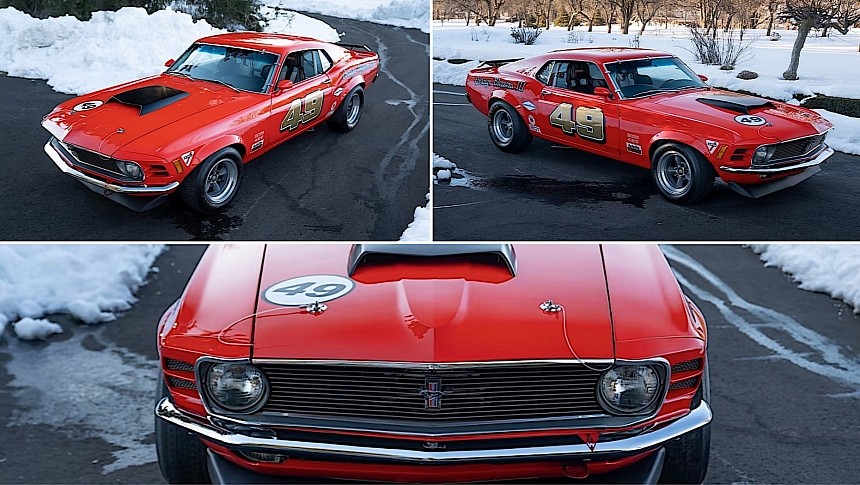It's almost impossible to find any car out there that's more appealing than a homologation model. But within their own ranks, these special vehicles have their own stars, examples that stood out over the years through achievements, fittings, or even ownership.
One of the homologation special families is that of the Boss 429. We know it today as perhaps the most valuable product of the muscle car era. Back in the day, though, it was a necessary evil as Ford was trying to take on the likes of the Charger Daytona and Plymouth Superbird.
Because it's a homologation model, not that many of them were made, and this adds to their value and appeal. Produced for just two years, 1969 and 1970, the Ford Mustang Boss 429 was made in 1,358 examples, all of them sold on the open market to abide by the NASCAR requirements.
The 429 you're looking at here is one of those few, and even if it was initially meant for use on public roads, it eventually was converted in 1974 to racing specification.
This allowed the car to be entered in a series of competitions, including the 12 Hours of and the 24 Hours of Daytona, from 1975 to 1977. Most importantly, it is one of just two cars of its breed known to have been raced in the IMSA Camel GT series.
It's not clear what happened to the Boss 429 after its racing career ended, but now we see it on the lot of cars going under the Mecum hammer in Indianapolis this coming weekend. It's selling with no reserve, but with an estimate of no less than a quarter of a million dollars, if the right crowd is in the house.
Like all others of its limited lineage, the Boss hides under the hood a 429ci engine linked to a four-speed manual transmission. Back in its day, this engine had a power output rating of 375 hp, although the reality is it developed much more than that, even as high as 500 hp.
The car wears a color called Calypso Coral over a black and simple interior, complete with Kirkey racing seats, Simpson harnesses, and a roll cage. On the sides its racing name, Orange Blossom III, can be seen, accompanied by all the fancy racing markings and the number 49 on the doors.
The current look of the car is owed to restoration work being performed at one point in the past. And it's not the only thing going for the car and the owner's high expectations: a ton of documentation is offered with it, including ownership history, race results, period photos, and even unnamed race memorabilia.
It remains to be seen if all of the above is enough to convince someone to pull $250,000 out of their pocket, and we'll come back to tell you that once we lear how it performed.
Because it's a homologation model, not that many of them were made, and this adds to their value and appeal. Produced for just two years, 1969 and 1970, the Ford Mustang Boss 429 was made in 1,358 examples, all of them sold on the open market to abide by the NASCAR requirements.
The 429 you're looking at here is one of those few, and even if it was initially meant for use on public roads, it eventually was converted in 1974 to racing specification.
This allowed the car to be entered in a series of competitions, including the 12 Hours of and the 24 Hours of Daytona, from 1975 to 1977. Most importantly, it is one of just two cars of its breed known to have been raced in the IMSA Camel GT series.
It's not clear what happened to the Boss 429 after its racing career ended, but now we see it on the lot of cars going under the Mecum hammer in Indianapolis this coming weekend. It's selling with no reserve, but with an estimate of no less than a quarter of a million dollars, if the right crowd is in the house.
Like all others of its limited lineage, the Boss hides under the hood a 429ci engine linked to a four-speed manual transmission. Back in its day, this engine had a power output rating of 375 hp, although the reality is it developed much more than that, even as high as 500 hp.
The car wears a color called Calypso Coral over a black and simple interior, complete with Kirkey racing seats, Simpson harnesses, and a roll cage. On the sides its racing name, Orange Blossom III, can be seen, accompanied by all the fancy racing markings and the number 49 on the doors.
The current look of the car is owed to restoration work being performed at one point in the past. And it's not the only thing going for the car and the owner's high expectations: a ton of documentation is offered with it, including ownership history, race results, period photos, and even unnamed race memorabilia.
It remains to be seen if all of the above is enough to convince someone to pull $250,000 out of their pocket, and we'll come back to tell you that once we lear how it performed.













